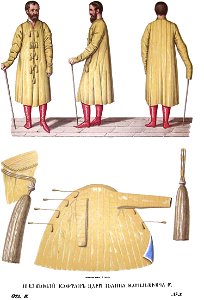Antiquities of the russian country, 1846-1853. Volume 4. Illustrator — ru: solntsev, fyodor grigorievich. Silk caftan of tsar ivan vasilyevich iv in the sacristy of the trinity lavra of st. Sergius, among other monuments, is kept a caftanets, or ferez, of tsar ivan vasilyevich, which was one of the garments of the ancient attire. This garment is made of silk material (gros de tour), yellowish or fawn in color, lined with a blue paper bay; underneath it is fluffed with white taffeta by half an inch; the narrow collar is stitched, like that of a tatar robe. The entire caftan is quilted with stripes. Its length is 1 arshin 14 vershoks, the width at the hem is 2 arshins 12 vershoks; the sleeves are 1 arshin 2 vershoks long. On the fields for fastening, four cords with silk tassels are sewn. In the description of the trinity lavra of st. Sergius, this clothing is called a ferez. The ferez, as can be seen from the cutting books, was a summer ferez, with a lining, and a winter ferez, warm with fur, sometimes with sleeves, and sometimes without sleeves, decorated with silk ties with tassels and warworks, which we see on the john's caftan, with samples or stripes. In small exits of the kings, the ferez replaced the caftan over the zipun; an opashen, or single-row, was put on over the ferez. Riding ferez, or ferezei, as an outer garment were put on an ordinary ferez, or chugu. In such a ferez, we see an image of tsar alexei mikhailovich, contemporary with him. It should be noted that the tsars observed a special ritual in using clothing: therefore, the clothing distributed among the outfits was elegant, or the outfit of the great treasury, table, spare, table, peace, or mourning, requiem, communion, mansion, walking, riding. If it seemed strange to anyone to come across the royal walking dress in the sacristy, where the sacred utensils of the trinity lavra are kept, we will point to the evidence of domestic chronicles that even in the churches themselves the clothes of the great princes were hung as a keepsake. Thus, in 1203, during the plunder of kyiv by rurik rostislavich and during the devastation of vladimir by the tatars in 1237, "they took the ports (i. E. Clothes) of the blessed first princes, which they had hung in the churches of the saints as a keepsake of themselves. " on holidays, precious clothes kept in the churches were exhibited. It is evident from the chronicle that in 1183 in vladimir klyazemsky, the ports, embroidered with gold and pearls, were hung in two ropes from the golden gate to the mother of god, and from the mother of god to the vladychny senya. The sovereign's fur coats, which in the old days were used to cover the royal coffins, were given to the moscow archangel cathedral. In accordance with this custom, tsar ivan vasilyevich probably left his fur coat in memory of himself in the trinity-sergius monastery, where he was received from the holy font. In the sacristy of the savvino-storozhevsky monastery, royal garments are kept: the dalmatic of tsar alexei mikhailovich, the opasni of tsarina maria ilyinichna and tsarevna sofia alekseyevna6, and in the solovetsky monastery - the armor of prince mikhail skopin-shuisky and prince dmitry pozharsky, who dedicated their victorious weapons to the church. An example of the dedication of weapons to the temple is seen in the iv book of kings (xi, 10), where it is mentioned that david's weapons were kept in the sanctuary. Date: between 1846 and 1853.
Loading...
